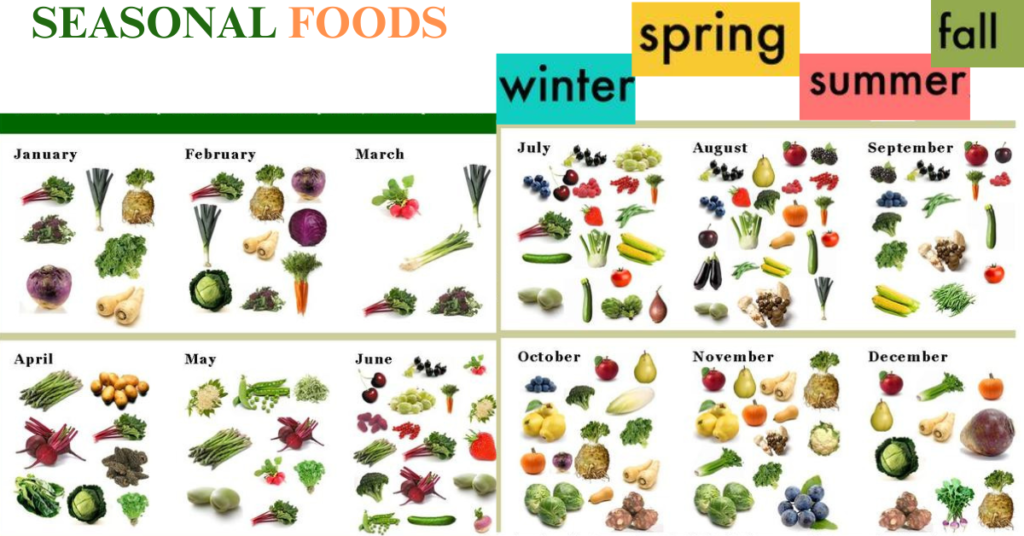Nutritional Benefits of Seasonal Foods
Seasonal Foods according to the seasons provides numerous benefits, including fresher and more nutritious foods, enhanced flavors, and envirEach season offers unique tastes and nutritional benefits, making our meals diverse and interesting throughout the year. Seasonal eating aligns with nature’s cycles, offering fresher, more nutritious options while also supporting environmental sustainability and local economies. Eating foods according to the seasons provides numerous benefits that extend beyond taste and variety.

Table of Contents
Peak Nutrient Content
Seasonal produce is harvested at its peak ripeness, ensuring it contains the maximum amount of vitamins, minerals, and antioxidants. When fruits and vegetables are allowed to ripen naturally, they develop a full spectrum of nutrients. For instance, summer berries are rich in antioxidants like vitamin C, which can diminish when stored for long periods. Similarly, root vegetables harvested in the fall are packed with nutrients that help sustain us through the winter months.
Better Flavor of Seasonal Foods
The flavor of fruits and vegetables that ripen naturally in their appropriate season is significantly superior to those grown out of season. A ripe summer tomato, for instance, tastes sweeter and juicier than one grown in a greenhouse during winter. This enhanced flavor makes meals more enjoyable and can encourage healthier eating habits.
Environmental Sustainability of Seasonal Foods
Reduced Carbon Footprint
Seasonal eating reduces the need for long-distance transportation, which lowers greenhouse gas emissions. When you choose locally grown, seasonal produce, you’re supporting farming practices that don’t require extensive travel and refrigeration. This reduction in transportation not only saves fuel but also minimizes the environmental impact associated with long-haul shipping.
Support for Local Farming
Purchasing seasonal produce supports local farmers and the regional economy. Local farming practices are often more sustainable and environmentally friendly compared to large-scale industrial agriculture. When you buy directly from farmers’ markets or local produce stands, you’re contributing to the livelihood of local farmers and encouraging sustainable farming practices that benefit the community and the environment.
Cost-Effectiveness of Seasonal Foods
Lower Prices
seasonal produce is more abundant and generally less expensive due to the lower costs of production and transportation. When a fruit or vegetable is in season, it’s often sold at a lower price because it’s available in larger quantities. This abundance reduces the need for expensive storage and artificial ripening processes, making seasonal produce more affordable for consumers.
Economic Stability
Buying locally supports the local economy, helping to maintain jobs and local businesses. When consumers purchase seasonal produce, they circulate money within their community, fostering economic stability and growth. This support is crucial for small-scale farmers and local businesses, which are often the backbone of rural economies.
Alignment with Natural Body Cycles

Body’s Nutritional Needs
Seasonal foods often align with the body’s nutritional needs for that time of year. For example, citrus fruits in winter provide vitamin C, which boosts the immune system during cold and flu season. Leafy greens and detoxifying foods available in spring help cleanse the body after a winter of heavier foods. This natural alignment supports overall health and well-being, ensuring that our diets are in harmony with our bodies’ needs throughout the year.
Dietary Variety of Seasonal Foods
Eating seasonally ensures a varied diet throughout the year, exposing the body to a wide range of nutrients and preventing nutritional monotony. This variety helps to ensure that you receive a broad spectrum of vitamins, minerals, and other essential nutrients. It also keeps meals interesting, reducing the likelihood of dietary boredom and encouraging healthier eating habits.
Enhanced Taste and Culinary Experience
Better Tasting Meals
Cooking with seasonal ingredients enhances the flavor and quality of meals, making home-cooked food more enjoyable. The fresh taste of seasonal produce can elevate even the simplest dishes, turning everyday meals into gourmet experiences. For example, a summer salad made with fresh tomatoes, cucumbers, and herbs tastes far superior to one made with out-of-season ingredients.
Cultural and Traditional Practices of Seasonal Foods
Many cultures have traditional dishes that revolve around seasonal foods ingredients, promoting a sense of cultural heritage and continuity. Seasonal eating connects us to our cultural roots and traditions, preserving recipes and cooking methods passed down through generations. This connection enriches our culinary experience, providing a deeper appreciation for the foods we eat and the cultural significance behind them.
Health Benefits of Seasonal Foods
Fewer Preservatives
Seasonal produce is less likely to require preservatives or artificial ripening agents. This means fewer chemicals and a more natural diet, which can lead to better overall health. Eating foods that are free from these additives reduces the risk of consuming potentially harmful substances, promoting a cleaner, healthier diet.
Freshness and Safety
Local seasonal produce is fresher and has a shorter time from farm to table, reducing the risk of contamination and foodborne illnesses. The shorter supply chain means that there is less time for produce to spoil or become contaminated, ensuring that the food you eat is as fresh and safe as possible. This freshness also contributes to better taste and nutritional quality.
Practical Tips for Seasonal Eating
Plan Your Meals Around Seasonal Produce
Start by familiarizing yourself with what fruits and vegetables are in season in your region. Many local agriculture extension offices and farmers’ markets provide seasonal produce guides. Use these guides to plan your meals, incorporating seasonal ingredients into your daily recipes.
Visit Farmers’ Markets
Farmers’ markets are excellent places to find fresh, seasonal produce. Not only do they offer a wide variety of fruits and vegetables, but they also provide an opportunity to speak directly with farmers. This direct interaction allows you to learn more about how your food is grown and to get tips on how to prepare and store seasonal produce.
Join a Community Supported Agriculture (CSA) Program
CSA programs allow you to purchase a share of a farm’s harvest, providing you with a regular supply of seasonal produce. Joining a CSA supports local agriculture and ensures you have a steady supply of fresh, seasonal fruits and vegetables. It’s also a great way to try new types of produce you might not normally buy.
Preserve Seasonal Produce
Preserving seasonal produce through methods like canning, freezing, and drying allows you to enjoy the flavors of each season year-round. This practice helps reduce food waste and ensures you have access to nutritious, flavorful produce even when it’s out of season. Preserving foods at their peak ripeness also maintains their nutritional value.
Conclusion of Seasonal Foods
Seasonal Foods Eating according to the seasons is a practice rooted in nature’s rhythms and cycles. It ensures better nutrition, supports local economies, reduces environmental impact, and enhances the culinary experience. By aligning our diets with the seasons, we can enjoy fresher, tastier, and more nutritious foods while contributing to a more sustainable and economically stable food system. Whether savoring summer berries or enjoying hearty winter root vegetables, seasonal eating is a rewarding and beneficial approach to nutrition. Embrace the natural bounty each season offers, and let your meals reflect the beauty and variety of the changing year.
The Nutritional Benefits of Seasonal Foods
When produce is consumed during its natural growing season, it is typically fresher and richer in nutrients. For example, strawberries picked in the summer are more likely to contain higher levels of vitamin C and antioxidants than those grown in artificial conditions during the winter. Fresh, ripe produce offers peak nutritional value, which supports overall health and well-being.
The Environmental Impact of Seasonal Eating
Eating seasonally reduces the need for long-distance transportation of out-of-season produce, which helps lower greenhouse gas emissions. Locally grown, seasonal foods often require fewer resources for transportation and storage, leading to a smaller carbon footprint. By choosing seasonal produce, consumers can significantly reduce their environmental impact and promote sustainable agricultural practices.
Economic Benefits of Seasonal Produce
Seasonal produce is often more affordable due to its abundance and lower production costs. Farmers can sell their seasonal harvest at lower prices because they save on storage and transportation expenses. Additionally, buying locally grown, seasonal foods supports local farmers and stimulates the regional economy. This economic stability benefits small-scale farmers and rural communities, fostering a stronger local food system.
Seasonal Foods Enhancing Culinary Variety and Flavor
Seasonal foods are fresher and more flavorful, enhancing the taste of meals. Fresh produce can turn simple dishes into culinary delights, making home cooking more enjoyable. Seasonal eating also encourages variety in the diet, as different fruits and vegetables come into season throughout the year. This variety ensures a broader range of nutrients and keeps meals interesting and satisfying.
Practical Steps to Embrace Seasonal Eating
To incorporate seasonal eating into your lifestyle, start by learning what produce is in season in your area. Visit local farmers’ markets to find fresh, seasonal fruits and vegetables and talk to farmers about their growing practices. Consider joining a Community Supported Agriculture (CSA) program to receive regular deliveries of seasonal produce. Additionally, preserving seasonal foods through canning


